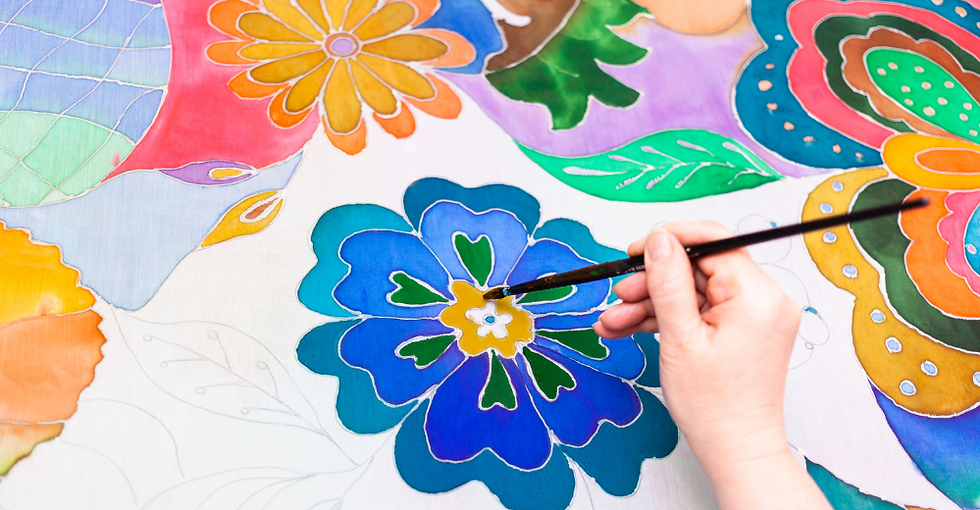Therapeutic Fabric Painting: Natural Dyes for Self-Expression
- Lauren Fallat, LPC LPAT ATR-BC

- Mar 18, 2024
- 3 min read
by Lauren Fallat, LPC LPAT ATR-BC
Fabric painting using natural dyes with items from the kitchen is a unique and gratifying art form that not only allows individuals to express their creativity but also engages them in a sensory-rich experience. The process involves extracting pigments from everyday kitchen ingredients such as fruits, vegetables, spices, and herbs to create a palette of vibrant and earthy hues. This eco-friendly approach not only promotes sustainability but also taps into the therapeutic benefits of connecting with nature and the inherent beauty of organic materials.
One of the most appealing aspects of using natural dyes is the element of unpredictability. Each batch of dye is inherently unique, influenced by the variability of natural ingredients and their interactions. This unpredictability adds an exciting dimension to the creative process, fostering a sense of exploration and spontaneity in art-making. Additionally, the use of natural dyes provides an opportunity to rediscover and appreciate traditional methods of dyeing, connecting individuals to the rich history of textile arts.
The act of creating natural dyes at home can be a meditative experience in itself. The process involves slow and deliberate steps, such as simmering ingredients, straining extracts, and patiently waiting for the colors to develop. Engaging in these activities can be a form of mindfulness, allowing individuals to focus on the present moment and immerse themselves in the sensory aspects of the creative process. The aromatic scents of simmering spices, the vibrant colors emerging from the raw materials, and the tactile experience of handling the fabrics create a multisensory environment that stimulates and engages the senses.
Fabric Painting and Art Therapy
Art therapy, as a discipline, recognizes the profound impact of creative expression on mental well-being. Fabric painting with natural dyes aligns perfectly with the principles of art therapy, offering individuals a channel to explore and communicate their emotions, thoughts, and experiences through a non-verbal medium. The tactile engagement with fabrics, the visual display of colors, and the olfactory stimulation of natural dyes create a holistic sensory experience that can be particularly beneficial for individuals seeking stress relief or emotional release.
Natural Dyes: Types and Uses
Moreover, the use of natural dyes in fabric painting introduces an element of connection to the environment. The awareness of where the colors come from and the sustainable nature of the process contribute to a sense of responsibility and mindfulness. This connection to nature, coupled with the act of self-expression through art, can be a powerful tool in promoting mental health and emotional well-being. As individuals immerse themselves in the creative process, they not only produce unique and aesthetically pleasing pieces of art but also embark on a journey of self-discovery and healing.
The world of spice-based fabric dyes offers a surprising range of colors. Here's a glimpse into this aromatic artist's palette:
Earthy Browns and Mustards: Cinnamon sticks, when simmered for extended periods, can yield a warm, earthy brown. Clove bud husks, with their deep reddish-brown tones, offer a similar richness. For a touch of golden mustard yellow, try using whole mustard seeds in the dye bath.
Sun-Kissed Yellows and Oranges: Paprika, a common kitchen staple, can surprise with a range of golden yellows depending on the type used. Experiment with smoked paprika for deeper amber tones. Saffron, the world's most expensive spice, can also be used to create a luxurious yellow dye, though be prepared for the price tag to be reflected in the final product.
Sultry Reds and Pinks: While paprika leans towards yellow, Spanish paprika, with its smokier character, can produce a rich, reddish-brown. For a brighter red, explore using hibiscus flowers, readily available dried or as a tea. For a more delicate pink, try simmering dried rose petals or the skins of red onions.
Unexpected Greens and Blues: Believe it or not, some spices can yield cool tones as well. Curry powder, with its blend of turmeric and other spices, can surprisingly create a muted olive green. For a more vibrant green, experiment with dried nettles, a readily available weed in many parts of the world. Black beans, steeped for long periods, can yield a surprisingly rich blue dye, perfect for achieving a unique indigo hue.
In conclusion, fabric painting with natural dyes made at home using items from the kitchen is a versatile and therapeutic art form. It blends creativity with a sensory-rich experience, fostering mindfulness and emotional expression. As individuals engage in this process, they not only create beautiful and unique artworks but also tap into the healing power of self-expression and connection with nature, making it a valuable tool in the realm of art therapy.
To Schedule an appointment, click on the Book an Appointment button.
To learn more about Holistic Health Counseling Center, please visit out website at www.hhccnj.com To read our latest blog, see this page: https://holistichealthcounselingcenter.com/blog/




Comments